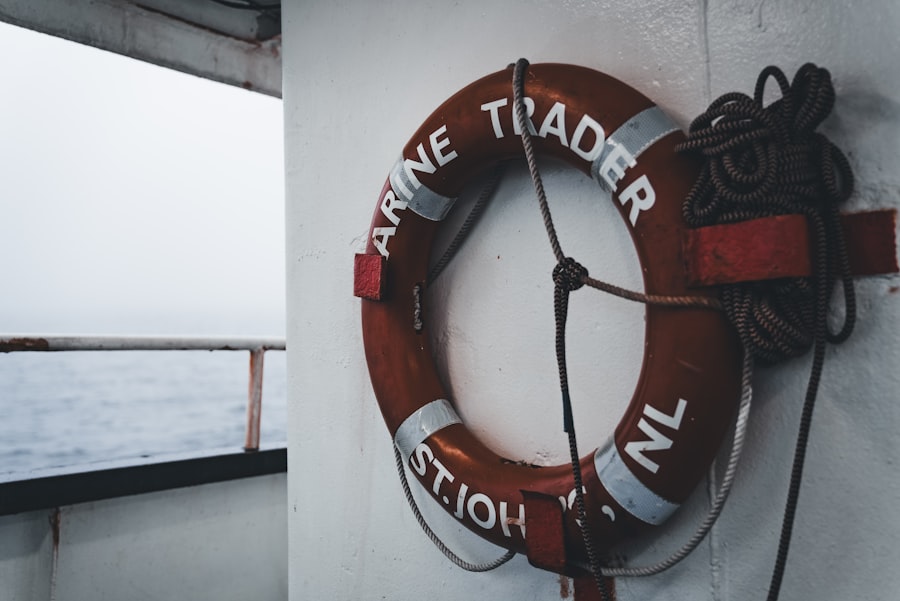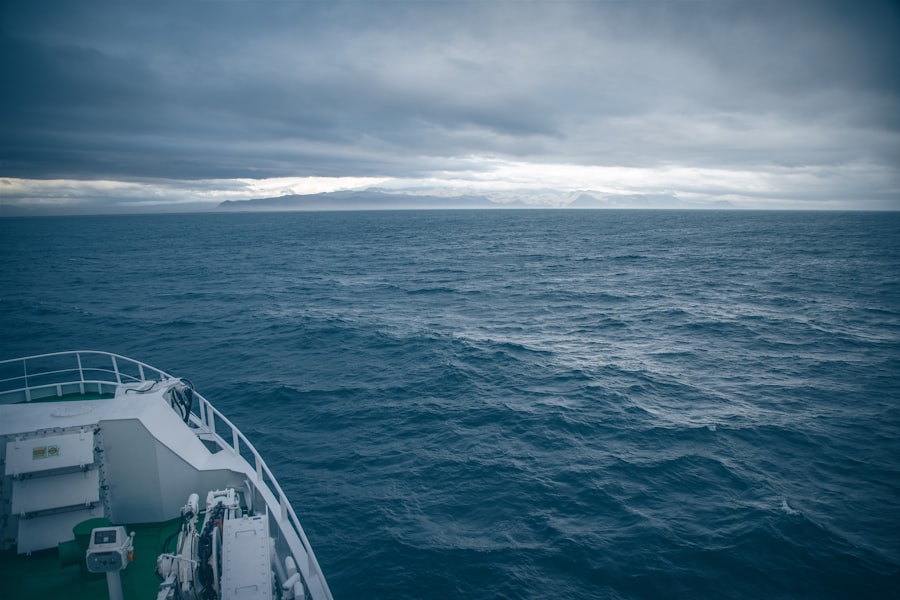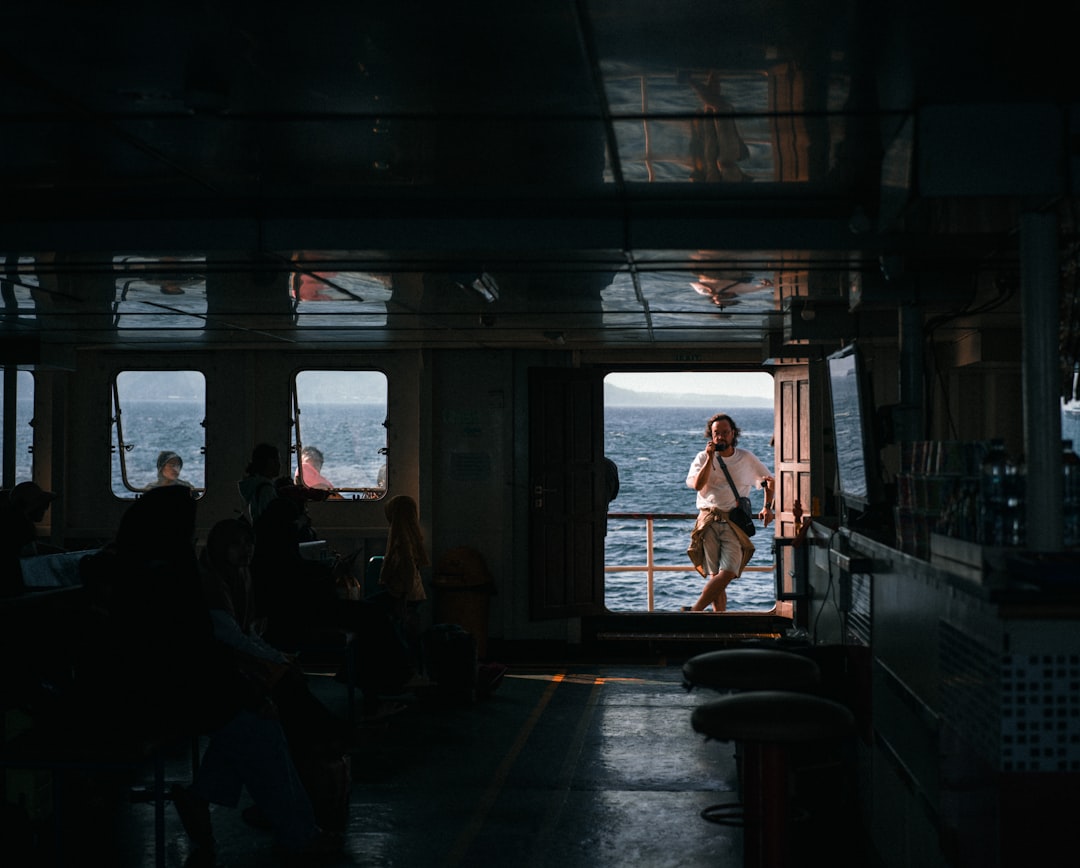The Drake Passage, a body of water that separates South America from Antarctica, is renowned for its tumultuous seas and unpredictable weather. Stretching approximately 600 miles, this passage is often regarded as one of the most challenging maritime routes in the world. The confluence of the Atlantic and Pacific Oceans creates a unique environment where strong currents and fierce winds converge, resulting in rough waters that can test even the most seasoned sailors.
The passage is not merely a geographical feature; it is a formidable barrier that has shaped the history of exploration and maritime navigation. Navigating the Drake Passage requires not only skill but also a deep respect for the ocean’s power. The waters are notorious for their swells, which can reach heights of up to 30 feet during storms.
This unpredictability has earned the passage a reputation that deters many from attempting to cross it. However, for adventurers and explorers, the challenge is part of the allure. The Drake Passage serves as a gateway to the pristine landscapes of Antarctica, drawing those who seek to experience its breathtaking beauty and unique wildlife.
Despite its dangers, the passage remains a vital route for research vessels, cruise ships, and explorers eager to embark on an unforgettable journey.
Key Takeaways
- The Drake Passage is a challenging route known for its rough seas and unpredictable weather, making it a thrilling but demanding journey.
- Crossing the Drake Passage has a rich history dating back to the age of exploration, with tales of daring expeditions and maritime adventures.
- Proper planning and preparation are essential for a successful journey across the Drake Passage, including packing appropriate gear and mentally preparing for the conditions.
- The wildlife and scenery of the Drake Passage are breathtaking, offering opportunities to see diverse marine life and stunning landscapes.
- Navigating the unpredictable weather of the Drake Passage requires skilled seamanship and careful attention to safety measures and precautions.
The History of Crossing the Drake Passage
The history of crossing the Drake Passage is steeped in tales of bravery and exploration. Early navigators faced immense challenges as they sought to chart these treacherous waters. In the 16th century, explorers like Sir Francis Drake, after whom the passage is named, ventured into these uncharted territories in search of new trade routes and territories.
Their journeys were fraught with peril, as they battled fierce storms and navigated through icy waters, often relying on rudimentary maps and their instincts to guide them. As maritime technology advanced, so too did the ability to traverse the Drake Passage. The 19th century saw an increase in scientific expeditions aimed at understanding the Antarctic region.
Notable figures such as Ernest Shackleton and Robert Falcon Scott undertook perilous voyages across the passage, driven by a desire to explore the unknown. Their expeditions not only contributed to our understanding of polar regions but also highlighted the human spirit’s resilience in the face of adversity. Today, the passage continues to be a significant route for researchers and tourists alike, bridging the gap between continents and offering a glimpse into the wonders of Antarctica.
Planning and Preparing for the Journey

Planning a journey across the Drake Passage requires careful consideration and preparation. Travelers must first decide on their mode of transport, whether it be a cruise ship or a research vessel. Each option presents its own set of advantages and challenges.
Cruise ships often provide a more comfortable experience with amenities that cater to tourists, while research vessels may offer a more rugged adventure for those seeking an authentic experience. Regardless of the choice, travelers should ensure that they are equipped with appropriate gear for varying weather conditions. Preparation also involves understanding the timing of the journey.
The best time to cross the Drake Passage is during the austral summer months, from November to March, when weather conditions are generally milder. However, even during this period, travelers should be prepared for sudden changes in weather. It is advisable to pack layers of clothing, waterproof gear, and seasickness medication to ensure comfort throughout the journey.
Additionally, travelers should familiarize themselves with safety protocols and emergency procedures specific to their vessel, as knowledge can be crucial in navigating unexpected challenges.
The Wildlife and Scenery of the Drake Passage
| Category | Metrics |
|---|---|
| Wildlife | Penguins, seals, whales, albatross |
| Scenery | Spectacular icebergs, glaciers, mountains |
| Weather | Unpredictable, strong winds, rough seas |
| Activities | Photography, bird watching, wildlife spotting |
One of the most captivating aspects of crossing the Drake Passage is the opportunity to witness its diverse wildlife and stunning scenery. The waters are teeming with life, serving as a feeding ground for various species of seabirds, including albatrosses and petrels. These magnificent birds can often be seen gliding gracefully above the waves, their wings spanning impressive lengths as they ride the ocean’s currents.
For wildlife enthusiasts, spotting these birds is just one highlight of an unforgettable journey. In addition to avian life, marine mammals such as whales frequently grace the waters of the Drake Passage. Humpback whales, orcas, and even minke whales can be spotted during crossings, providing travelers with awe-inspiring moments as these majestic creatures breach the surface.
The scenery itself is equally breathtaking; travelers are treated to panoramic views of rugged coastlines, towering icebergs, and expansive ocean vistas that stretch as far as the eye can see. The stark beauty of this remote region serves as a reminder of nature’s grandeur and fragility.
Navigating the Unpredictable Weather
The weather in the Drake Passage is notoriously unpredictable, presenting both challenges and opportunities for those who dare to cross it. Conditions can change rapidly, with calm seas transforming into turbulent waters within minutes. This volatility is primarily due to the convergence of different oceanic currents and weather systems that collide in this region.
As such, travelers must remain vigilant and adaptable throughout their journey. To navigate these unpredictable conditions effectively, it is essential for travelers to stay informed about weather forecasts and updates from their vessel’s crew. Modern technology has improved forecasting accuracy; however, it remains crucial to heed warnings and advice from experienced sailors who understand the nuances of this challenging environment.
Those crossing the Drake Passage should also be prepared for potential delays or changes in itinerary due to adverse weather conditions. Embracing flexibility can enhance the overall experience, allowing travelers to appreciate the raw power of nature while safely navigating its challenges.
The Experience of Crossing the Drake Passage

Crossing the Drake Passage is an experience that transcends mere travel; it is an adventure that tests one’s limits and ignites a sense of wonder. As travelers embark on their journey, they are often filled with anticipation and excitement mixed with a hint of trepidation about what lies ahead. The initial moments on board are marked by a sense of camaraderie among passengers who share a common goal: to conquer this formidable passage together.
As the vessel sets sail into open waters, passengers may find themselves captivated by the rhythmic motion of the waves and the salty sea breeze that fills the air. The experience can be both exhilarating and humbling as one contemplates the vastness of the ocean surrounding them. For many, crossing the Drake Passage becomes a rite of passage—a testament to their adventurous spirit and willingness to embrace uncertainty.
Each wave that crashes against the hull serves as a reminder of nature’s power and beauty, leaving an indelible mark on those fortunate enough to undertake this journey.
Safety Measures and Precautions
Safety is paramount when crossing the Drake Passage, given its reputation for rough seas and unpredictable weather patterns. Vessels undertaking this journey are equipped with advanced safety measures designed to protect passengers and crew alike. Before departure, travelers receive thorough briefings on safety protocols, including emergency procedures and guidelines for behavior during rough seas.
Passengers are encouraged to familiarize themselves with life jackets’ locations and usage instructions while remaining aware of their surroundings at all times. It is also advisable for travelers to stay informed about potential hazards associated with sea travel, such as sudden changes in weather or rough waters. By adhering to safety guidelines and remaining vigilant throughout their journey, passengers can significantly reduce risks while enjoying their adventure across this challenging passage.
Activities and Excursions during the Journey
While crossing the Drake Passage may involve long hours at sea, there are numerous activities and excursions available to keep passengers engaged and entertained throughout their journey. Many vessels offer educational programs led by experienced naturalists who provide insights into the unique ecosystems found in this region. Passengers can participate in lectures about marine biology, geology, and climate change while gaining a deeper understanding of Antarctica’s significance.
In addition to educational opportunities, some vessels organize guided excursions that allow passengers to explore nearby islands or participate in wildlife watching activities. Kayaking among icebergs or embarking on small boat excursions can provide an up-close view of marine life while offering unique perspectives on stunning landscapes. These activities not only enhance the overall experience but also foster connections among travelers who share a passion for exploration and adventure.
The Significance of Crossing the Drake Passage
Crossing the Drake Passage holds profound significance beyond its physical challenges; it represents a connection between continents and cultures while serving as a gateway to one of Earth’s last frontiers—Antarctica. This passage has historically been a vital route for explorers seeking knowledge about our planet’s polar regions while contributing to scientific research that informs our understanding of climate change and environmental conservation. Moreover, crossing this passage symbolizes humanity’s enduring spirit of exploration—a testament to our innate curiosity about what lies beyond familiar horizons.
For many travelers, successfully navigating these waters becomes more than just an adventure; it transforms into a personal milestone that inspires future journeys into uncharted territories. The significance lies not only in reaching Antarctica but also in embracing challenges along the way—an experience that resonates deeply within those who dare to cross this remarkable passage.
Tips for Making the Most of the Adventure
To maximize enjoyment during a journey across the Drake Passage, travelers should consider several practical tips that enhance their overall experience. First and foremost, maintaining an open mind is essential; embracing spontaneity can lead to unexpected discoveries along the way.
Additionally, staying connected with nature is vital during this journey—taking time to observe wildlife or simply appreciating breathtaking views can create lasting memories. Travelers should also prioritize self-care by staying hydrated and nourished throughout their voyage; maintaining energy levels will ensure they remain engaged in activities offered on board or during excursions. Lastly, documenting experiences through journaling or photography allows travelers to capture moments that may otherwise fade with time—these reflections serve as cherished reminders long after returning home from this extraordinary adventure.
Reflections and Memories of Crossing the Drake Passage
As travelers reflect on their experiences crossing the Drake Passage, they often find themselves filled with gratitude for having undertaken such an extraordinary journey. The memories created during this adventure—whether it be witnessing majestic whales breaching or sharing laughter with newfound friends—become treasured stories that are recounted for years to come. The challenges faced during this crossing often foster personal growth; many individuals emerge from their experiences with newfound confidence in their abilities to navigate uncertainty both at sea and in life itself.
Ultimately, crossing the Drake Passage becomes more than just a physical journey; it transforms into an exploration of self-discovery—a testament to resilience amid nature’s grandeur. In conclusion, crossing the Drake Passage is an adventure that encapsulates both challenge and beauty—a journey that leaves an indelible mark on all who dare to embark upon it. From its rich history steeped in exploration to its breathtaking wildlife encounters amidst unpredictable weather patterns—the passage offers an unparalleled experience that resonates deeply within those fortunate enough to traverse its waters.
Crossing the Drake Passage is often described as a thrilling yet challenging experience, with its unpredictable weather and rough seas testing even the most seasoned travelers.
This article delves into the experiences of travelers who have braved the Drake Passage, offering insights and tips for those considering the journey. You can read more about these fascinating accounts by visiting the following link: MyGeoQuest Article on Crossing the Drake Passage.
WATCH NOW! Drake Passage: Earth’s Deadliest Waters Revealed
FAQs
What is the Drake Passage?
The Drake Passage is the body of water between the southern tip of South America and the northern tip of the Antarctic Peninsula. It is known for its rough seas and challenging sailing conditions.
What is it like to cross the Drake Passage?
Crossing the Drake Passage can be a challenging and exhilarating experience. The waters are often rough, with strong winds and large waves. It is not uncommon for passengers to experience seasickness during the crossing.
How long does it take to cross the Drake Passage?
The crossing of the Drake Passage typically takes around 2-3 days, depending on weather conditions and the route taken by the vessel.
What are the weather conditions like in the Drake Passage?
The weather in the Drake Passage can be unpredictable and harsh. It is known for strong winds, rough seas, and rapidly changing conditions. Storms and fog are common in the area.
What wildlife can be seen in the Drake Passage?
The Drake Passage is home to a variety of wildlife, including seabirds, whales, and seals. Passengers may have the opportunity to see albatross, petrels, and other seabirds, as well as whales such as humpback and orca.
Is crossing the Drake Passage dangerous?
Crossing the Drake Passage can be challenging and potentially dangerous due to the rough seas and unpredictable weather. However, experienced captains and modern vessels make the crossing as safe as possible.
